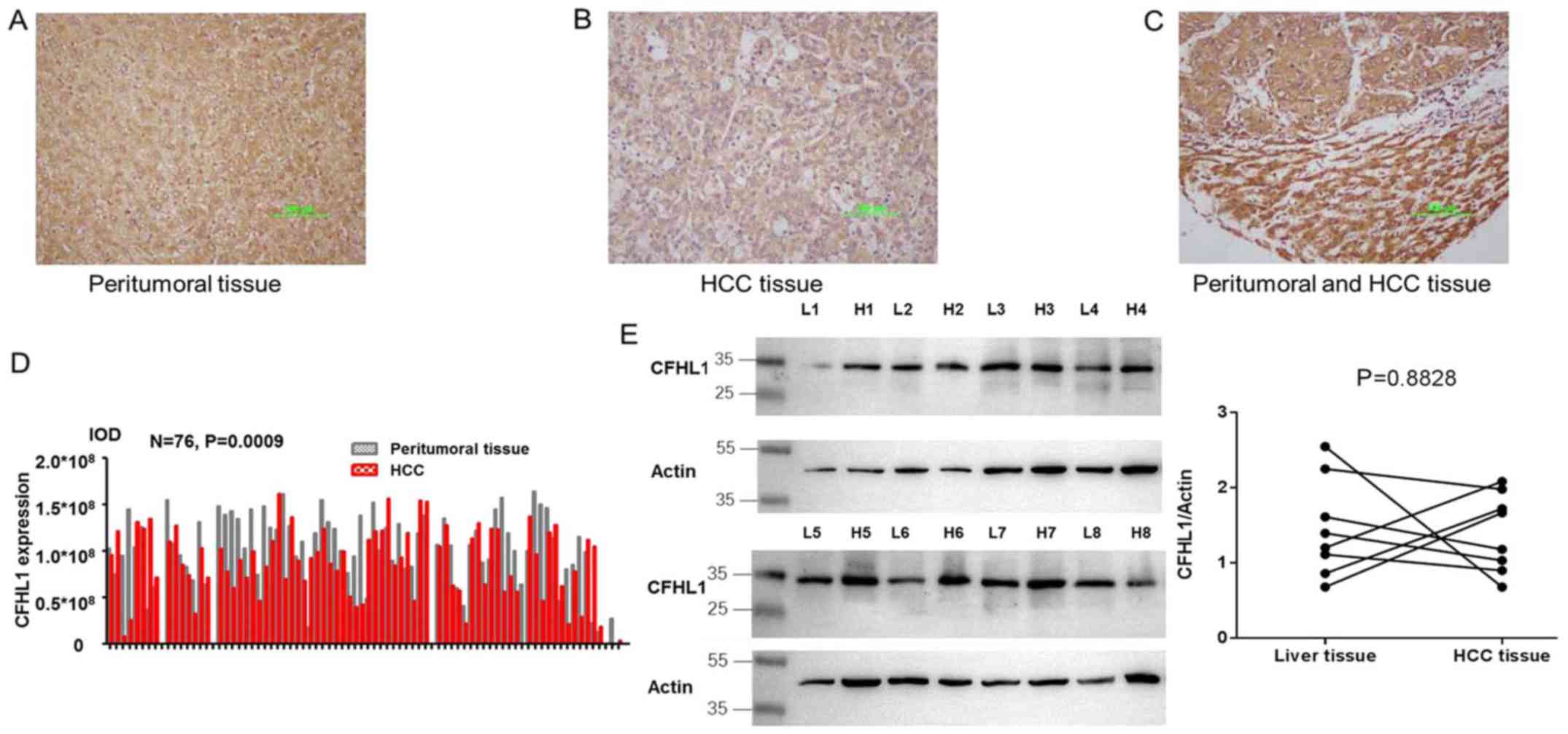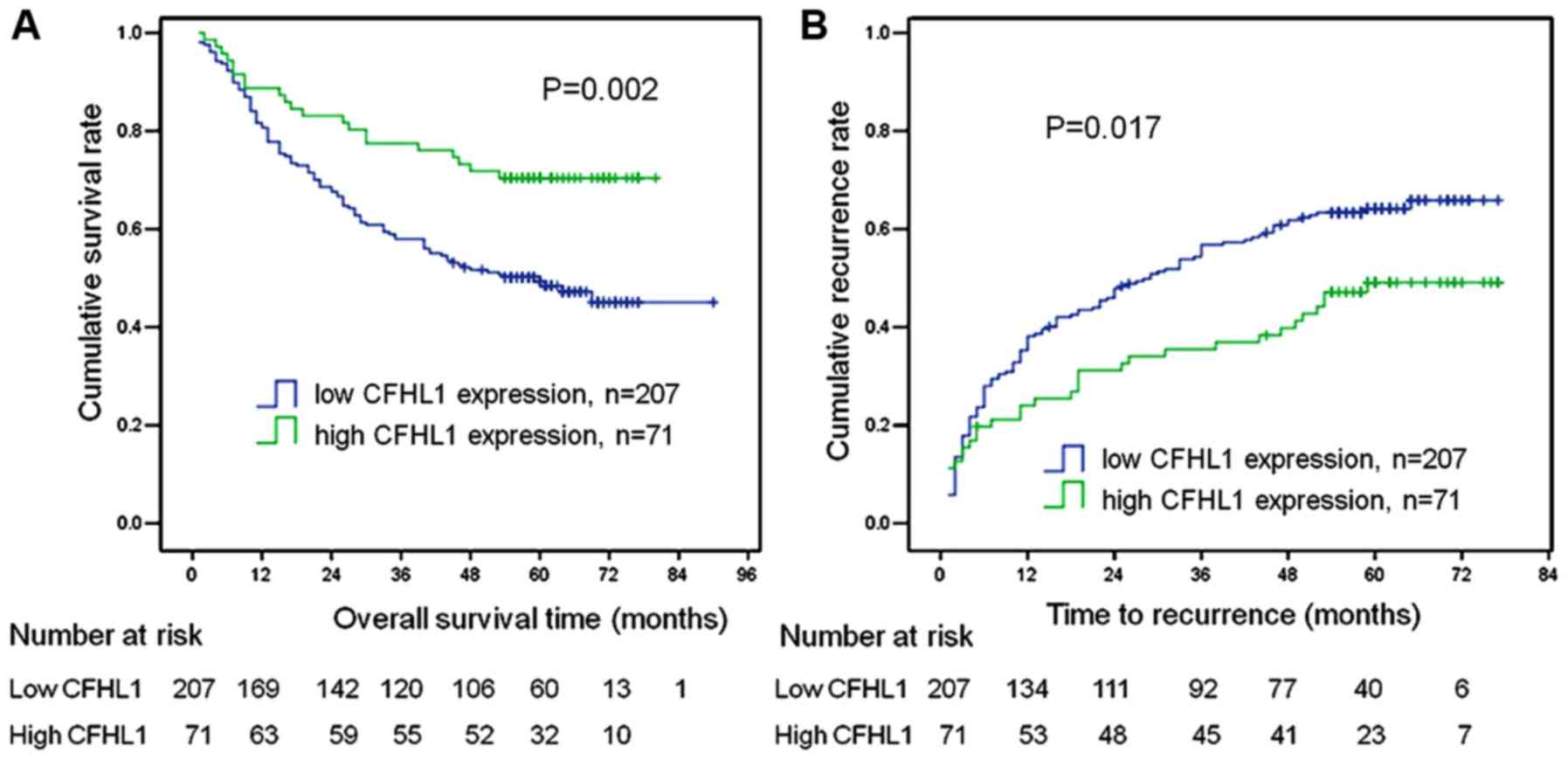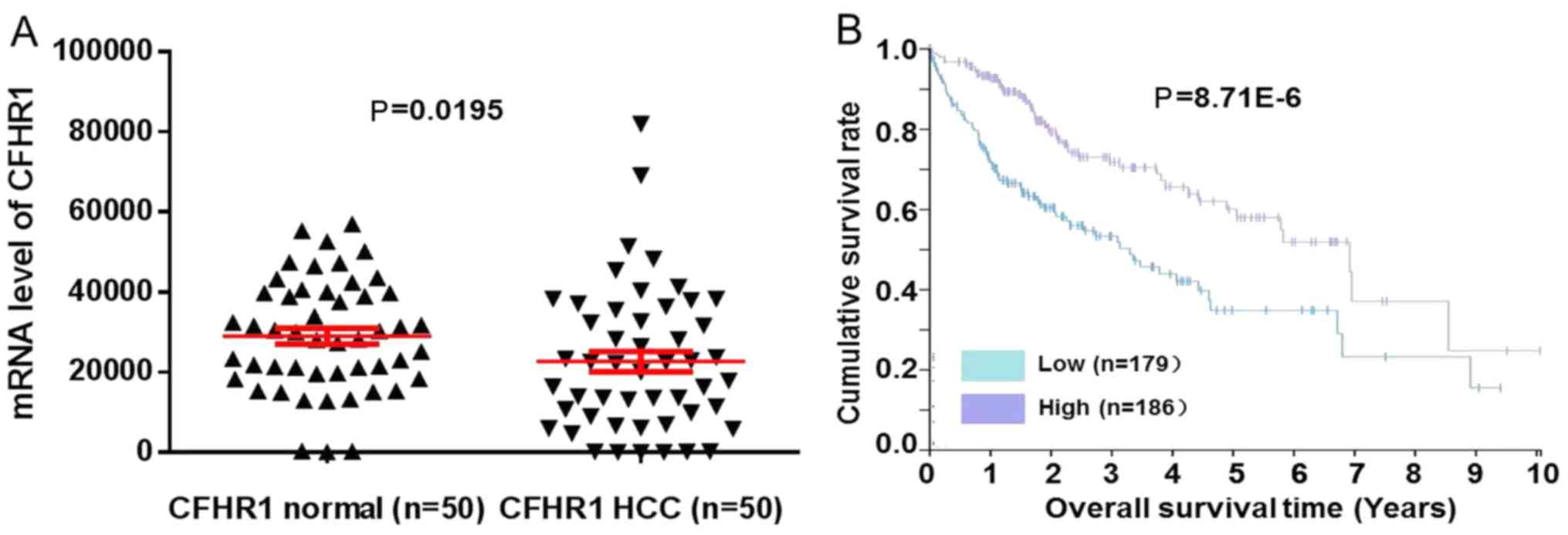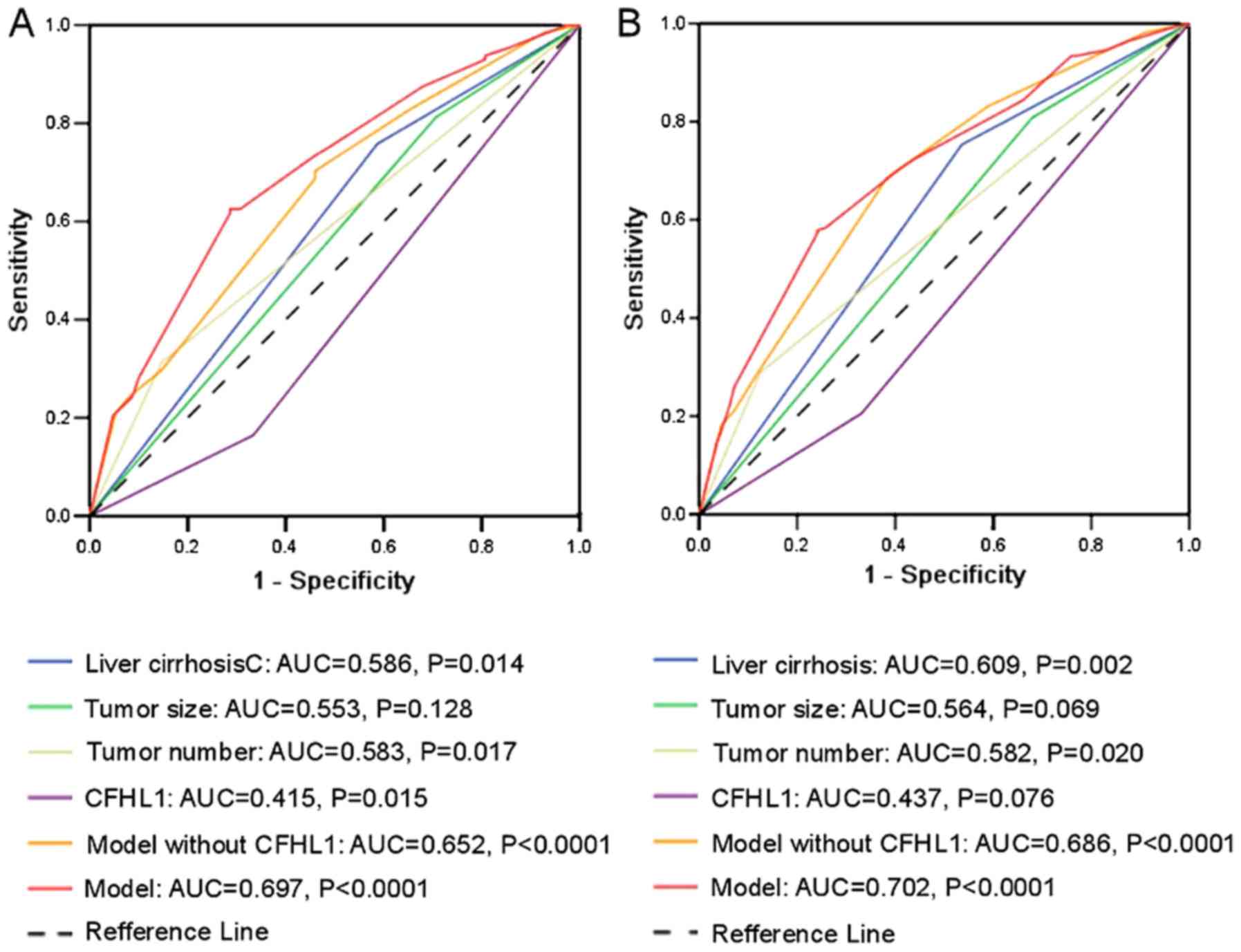|
1
|
Li F, Guo Z and Wang H: Influencing
elements and treatment strategies associated with the relapse of
hepatocellular carcinoma after surgery. Hepatogastroenterology.
60:1148–1155. 2013.PubMed/NCBI
|
|
2
|
Bruix J and Sherman M; Practice Guidelines
Committee, American Association for the Study of Liver Diseases, :
Management of hepatocellular carcinoma. Hepatology. 42:1208–1236.
2005. View Article : Google Scholar : PubMed/NCBI
|
|
3
|
Umeda S, Kanda M and Kodera Y: Emerging
evidence of molecular biomarkers in hepatocellular carcinoma.
Histol Histopathol. 33:343–355. 2018.PubMed/NCBI
|
|
4
|
Skerka C, Timmann C, Horstmann RD and
Zipfel PF: Two additional human serum proteins structurally related
to complement factor H. Evidence for a family of factor H-related
genes. J Immunol. 148:3313–3318. 1992.PubMed/NCBI
|
|
5
|
Siegel C, Hallström T, Skerka C, Eberhardt
H, Uzonyi B, Beckhaus T, Karas M, Wallich R, Stevenson B, Zipfel PF
and Kraiczy P: Complement factor H-related proteins CFHR2 and CFHR5
represent novel ligands for the infection-associated CRASP proteins
of Borrelia burgdorferi. PLoS One. 5:e135192010. View Article : Google Scholar : PubMed/NCBI
|
|
6
|
Kinders R, Jones T, Root R, Bruce C,
Murchison H, Corey M, Williams L, Enfield D and Hass GM: Complement
factor H or a related protein is a marker for transitional cell
cancer of the bladder. Clin Cancer Res. 4:2511–2520.
1998.PubMed/NCBI
|
|
7
|
Heicappell R, Wettig IC, Schostak M,
Müller M, Steiner U, Sauter T and Miller K: Quantitative detection
of human complement factor H-related protein in transitional cell
carcinoma of the urinary bladder. Eur Urol. 35:81–87. 1999.
View Article : Google Scholar : PubMed/NCBI
|
|
8
|
Malkowicz SB: The application of human
complement factor H-related protein (BTA TRAK) in monitoring
patients with bladder cancer. Urol Clin North Am. 2763–73.
(ix)2000. View Article : Google Scholar : PubMed/NCBI
|
|
9
|
Yang JD, Seol SY, Leem SH, Kim YH, Sun Z,
Lee JS, Thorgeirsson SS, Chu IS, Roberts LR and Kang KJ: Genes
associated with recurrence of hepatocellular carcinoma: Integrated
analysis by gene expression and methylation profiling. J Korean Med
Sci. 26:1428–1438. 2011. View Article : Google Scholar : PubMed/NCBI
|
|
10
|
Jin GZ, Yu WL, Dong H, Zhou WP, Gu YJ, Yu
H, Yu H, Lu XY, Xian ZH, Liu YK, et al: SUOX is a promising
diagnostic and prognostic biomarker for hepatocellular carcinoma. J
Hepatol. 59:510–517. 2013. View Article : Google Scholar : PubMed/NCBI
|
|
11
|
Tan N, Liu Q, Liu X, Gong Z, Zeng Y, Pan
G, Xu Q and He S: Low expression of B-cell-associated protein 31 in
human primary hepatocellular carcinoma correlates with poor
prognosis. Histopathology. 68:221–229. 2016. View Article : Google Scholar : PubMed/NCBI
|
|
12
|
Kononen J, Bubendorf L, Kallioniemi A,
Bärlund M, Schraml P, Leighton S, Torhorst J, Mihatsch MJ, Sauter G
and Kallioniemi OP: Tissue microarrays for high-throughput
molecular profiling of tumor specimens. Nat Med. 4:844–847. 1998.
View Article : Google Scholar : PubMed/NCBI
|
|
13
|
Jin GZ, Li Y, Cong WM, Yu H, Dong H, Shu
H, Liu XH, Yan GQ, Zhang L, Zhang Y, et al: iTRAQ-2DLC-ESI-MS/MS
based identification of a new set of immunohistochemical biomarkers
for classification of dysplastic nodules and small hepatocellular
carcinoma. J Proteome Res. 10:3418–3428. 2011. View Article : Google Scholar : PubMed/NCBI
|
|
14
|
Zhu XD, Zhang JB, Zhuang PY, Zhu HG, Zhang
W, Xiong YQ, Wu WZ, Wang L, Tang ZY and Sun HC: High expression of
macrophage colony-stimulating factor in peritumoral liver tissue is
associated with poor survival after curative resection of
hepatocellular carcinoma. J Clin Oncol. 26:2707–2716. 2008.
View Article : Google Scholar : PubMed/NCBI
|
|
15
|
Jin H, Wang C, Jin G, Ruan H, Gu D, Wei L,
Wang H, Wang N, Arunachalam E, Zhang Y, et al: Regulator of
calcineurin 1 gene isoform 4, down-regulated in hepatocellular
carcinoma, prevents proliferation, migration, and invasive activity
of cancer cells and metastasis of orthotopic tumors by inhibiting
nuclear translocation of NFAT1. Gastroenterology. 153:799–811.e33.
2017. View Article : Google Scholar : PubMed/NCBI
|
|
16
|
Camp RL, Dolled-Filhart M and Rimm DL:
X-tile: A new bio-informatics tool for biomarker assessment and
outcome-based cut-point optimization. Clin Cancer Res.
10:7252–7259. 2004. View Article : Google Scholar : PubMed/NCBI
|
|
17
|
Losse J, Zipfel PF and Józsi M: Factor H
and factor H-related protein 1 bind to human neutrophils via
complement receptor 3, mediate attachment to Candida albicans, and
enhance neutrophil antimicrobial activity. J Immunol. 184:912–921.
2010. View Article : Google Scholar : PubMed/NCBI
|
|
18
|
Siegel C, Schreiber J, Haupt K, Skerka C,
Brade V, Simon MM, Stevenson B, Wallich R, Zipfel PF and Kraiczy P:
Deciphering the ligand-binding sites in the Borrelia
burgdorferi complement regulator-acquiring surface protein 2
required for interactions with the human immune regulators factor H
and factor H-like protein 1. J Biol Chem. 283:34855–34863. 2008.
View Article : Google Scholar : PubMed/NCBI
|














